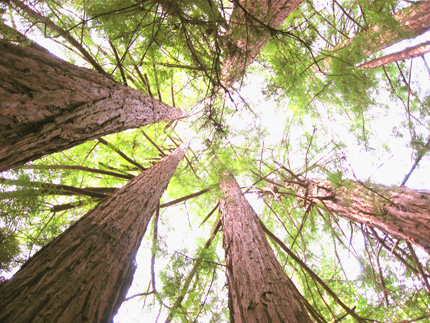
Wild Big Sur: Redwoods
By Steven Harper
The wild beauty of Big Sur has inspired and awed humans since, and probably before, recorded time. Whether you are a first time visitor or a long-time local, I invite you take time to acquaint yourself and deepen with this wild landscape. Slow down enough to let the raw beauty of nature touch you as it so creatively manifests itself along the coast.
It is all too easy to pass through Big Sur drinking in only the visual landscape. Yet, as any good naturalist knows, it is best if you use all of your senses. The most accomplished naturalists I know have not only developed visual acuity, they have also awakened their sense of smell, touch, taste, and hearing. What better place than Big Sur to let your five (or six) senses come alive? The natural elements invite you to pay attention.
When I bring visitors into the coastal wilderness I often introduce them to the natural history of this area through its plants. Plants are generally accessible, easy to find, and rarely run or fly away. They are low on the food chain, occur in communities, and interrelate with many other plants and animals helping us to connect with the larger natural environment. Plants engage our senses with lush colors, rich smells, intricate textures, complex tastes, and, yes, even sounds.
Monterey County has at least 2,055 plant species in 131 families with 68 species listed as rare or endangered. Big Sur accounts for a great deal of the abundant variety that occurs in this county. Due to the distinctive climate and extreme topography of the region, in a short distance a traveler can pass through an incredible display of diversity. A virtual tapestry of plant communities — from ocean side to deep canyon, open hillside to high peaks — offers a variety of habitats for plants to find their unique niches. Of the many plants that make Big Sur their home, probably the best known and easiest to learn is the coast redwood. Redwoods in their sheer magnificence draw our attention.

I would like to share here some of the unique qualities of redwoods to deepen your appreciation of these ancient giants. The Redwood (Sequoia sempervirens) is the tallest living thing on earth, measuring at up to 379 feet high. Fossil ancestors of this ancient tree are found to have been widespread in the northern hemisphere over 100 million years ago. They currently range from the California-Oregon border in the north to Big Sur in the south, growing in a narrow band 5 to 30 miles wide along the coast. They are found from just above sea level up to over 3,000 feet. Redwoods often live from 600 to 1200 years while some have survived to 2200 years old. Redwoods grow in a unique relationship to coastal fog and have evolved in close relationship to fire. A single old-growth redwood can produce millions of pin-head-sized seeds annually; however, unlike any other North American conifer, they most commonly regenerate clonally by root sprout. Where trees have been cut or have fallen due to natural causes, there are often “fairy rings” where younger trees have grown from the original parent tree. Surprising to many, redwoods have shallow roots 3-9 feet deep, but growing out from the tree for several hundred feet. Incredibly, mature redwood forests produce the greatest biomass per acre of any other forest in the world— almost 10 times that of mature tropical rain forest.
If redwoods are new to you, they can be found at almost all of the state parks and much of the Forest Service land along the coast in Big Sur. Whether you are new or old to the wonder of redwoods, I encourage you to find a tree, sit still, open your senses, and let yourself be touch by wild Big Sur.
copyright Steven Harper all rights reserved